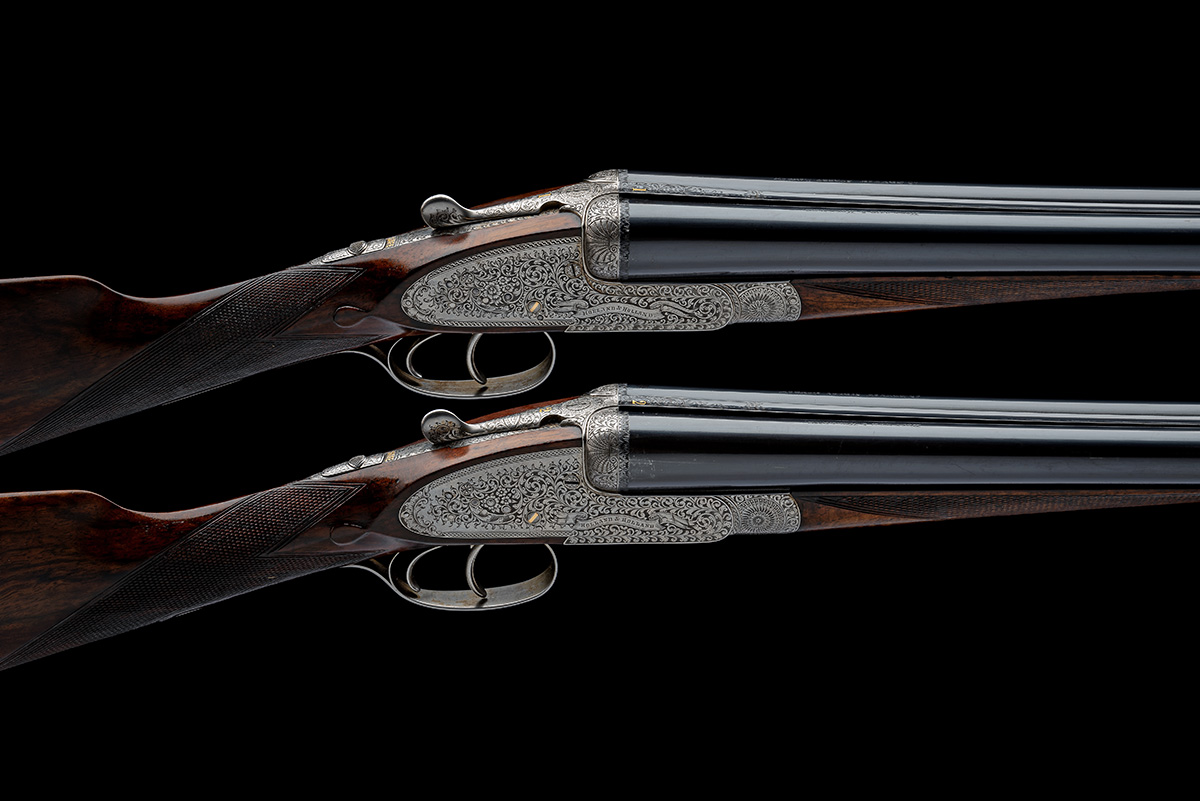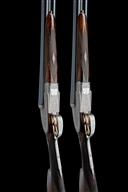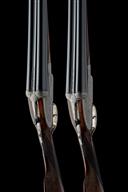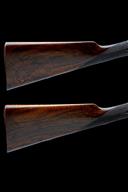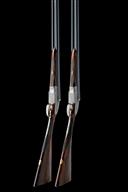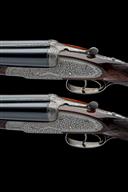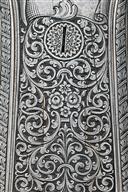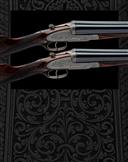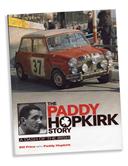Product Details
FORMERLY THE PROPERTY OF PATRICK 'PADDY' HOPKIRK M.B.E.
HOLLAND & HOLLAND
A MATCHED PAIR OF 12-BORE 'ROYAL HAMMERLESS EJECTOR' SIDELOCK EJECTORS, serial no. 22792 / 23662,
for 1902 and 1904, 27in. replacement nitro barrels (by the makers), ribs gold-inlaid '1' and '2', tubes engraved 'HOLLAND & HOLLAND. 13. BRUTON STREET. LONDON.', 2 3/4in. chambers, bored approx. imp. cyl. and 1/2 choke, fences carved with pseudanthium and shell motifs, toplevers gold-inlaid '1' and '2' and engraved 'PATENT EJECTOR', automatic safeties with gold-inlaid 'SAFE' details, gold-inlaid cocking-indicators, best 'Royal' scroll engraving with woven borderwork and interspersed with floral bouquets, the makers name engraved within a scrolling ribbon, the underside with further floral bouquets and 'ROYAL HAMMERLESS EJECTOR' engraved within an elaborate cartouche, bright finishes, 14 1/4in. figured replacement stocks (in 1915 by the makers), gold escutcheons engraved 'P.H.', weight 6lb. 5oz., in their makers brass-cornered oak and leather double guncase with internal protective flap, lid exterior marked 'P.H.'; together with a copy of 'The Paddy Hopkirk Story - A Dash of the Irish' by Bill Price with Paddy Hopkirk
Provenance: The makers have kindly confirmed that Gun No. 22792 was completed in 1902, and Gun No. 23662 was completed in 1905 to match. The records also indicate that the guns were restocked in April 1915. The guns were made for a 'Barran', and they are listed as being later sold to 'Hopkirk'.
Patrick Barron Hopkirk MBE (14 April 1933 - 21 July 2022) was born in Belfast, and is widely regarded as one of the United Kingdom and Ireland's finest rally drivers. Renowned for his exceptional skills behind the wheel, Hopkirk's career spanned several decades and left an indelible mark on the sport.
Facing academic challenges due to dyslexia, he learned the basics of car control at the age of 9 when a local clergyman left him his invalid carriage in his will. He learned to master its motorcycle engine and rear-wheel brakes, noting that "it taught you quite a lot about skid control". The carriage was followed by a motorcycle and sidecar, and then an Austin 7 'Chummy' Tourer in which he made his rally debut. Bitten by the racing bug, Hopkirk dropped out of Trinity College, Dublin, to work for Volkswagen near Dublin. Hopkirk's first win came in 1953 at the Cairncastle hill climb at the wheel of a used V.W. Beetle.
It was in a similar car that he competed in the Circuit of Ireland rally for the first time in 1953. Two years later, driving a Triumph TR2, he took a class win in the event and won his first Hewison trophy for the most successful Irish rally driver of the year; a trophy he would win for three consecutive years. Offered a seat by the Standard Motor Company, he led the early stages of the 1956 British rally and finished third in the Tulip Rally in the Netherlands.
The following year Hopkirk joined the Rootes Group, driving a Hillman Husky in the Safari rally. Later that year he placed third overall and took a class win at the Alpine Rally in a Sunbeam Rapier, and he led the 1960 Safari Rally until his Rapier suffered a differential failure. He took two Circuit of Ireland wins in 1961 and 1962 and another third at the Alpine Rally in 1961. Whilst at Rootes, Hopkirk also took part in circuit racing, winning his class in a Rapier in the touring car race supporting the 1960 British Grand Prix.
Hopkirk finished third at the 1962 Monte Carlo Rally in a Sunbeam Rapier. However, Hopkirk was becoming frustrated by the Rapier's lack of reliability, culminating in all three works cars blowing their engines within the space of a kilometre at that year's Acropolis Rally. Moving to the British Motor Corporation (BMC), he first competed in a Mini at the 1963 Monte Carlo Rally, where he finished sixth.
For the three-day midwinter Monte Carlo rally in 1964, Hopkirk and his co-driver Henry Liddon elected to start from Minsk in the Soviet Union. Racing the iconic Mini Cooper S, they navigated treacherous and icy conditions to win the rally, outmanoeuvring more powerful cars from Ford, Mercedes and Saab. The victory in the diminutive car, which came to symbolise cultural Britain in the 1960's, was cause for national celebration and made Hopkirk a household name: he received telegrams from the Beatles and the UK Prime Minister, and appeared along with his Mini on 'Sunday Night at the London Palladium'.
In 1968, at the London-Sydney Marathon, Hopkirk gave up the chance of victory on the penultimate stage to save a competing rival, whose Citroën DS had just collided head-on with another car on a road supposedly closed to traffic. Hopkirk and his teammate managed to rescue the occupants from both cars that were starting to burn, likely saving the life of severely wounded Lucien Bianchi in the process. The accident happened just ahead of Hopkirk's Austin 1800. By driving back to warn onlookers and the police, Hopkirk and Nash likely also prevented another crash with any incoming participants. Hopkirk completed the rally in second place.
His retirement from competition at the end of the 1960s allowed Paddy Hopkirk to concentrate on his businesses, including a driving school. In 2016 he was appointed MBE for charitable activities, and he used his profile and network to get organisations such as the BRDC to take part and help to raise the profile of further driver training as a way to save lives on the road.
Please click HERE to view Terms & Conditions. Please note all Lots are listed in accordance with UK Law, for overseas buyers, please ensure you are familiar with your relevant local firearms and customs regulations before bidding.
Estimate £7,000-9,000
S2 - Sold as a Section 2 Firearm under the 1968 Firearms Act

